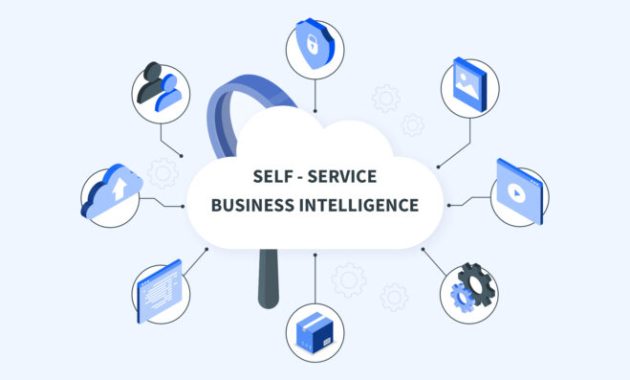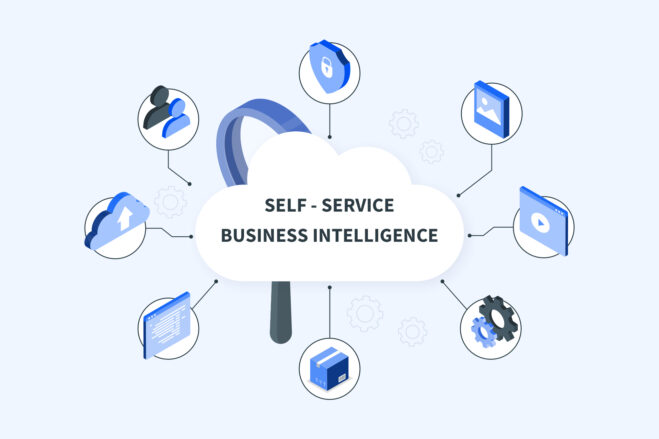
Self-Service Business Intelligence Software: A Paradigm Shift in Cost Management
In today’s data-driven world, businesses are constantly seeking ways to gain a competitive edge. One of the most effective strategies involves leveraging the power of data analytics. This is where self-service business intelligence (BI) software comes into play. It empowers users to analyze data and make informed decisions without relying heavily on IT or specialized data analysts. This shift not only accelerates decision-making but also provides significant opportunities for cutting costs.
This article will delve into the world of self-service business intelligence software. We will explore how it cuts costs, its key features, its benefits, and how businesses can implement it effectively. We will also look at real-world examples and future trends in this rapidly evolving field. The primary focus will be on understanding the tangible ways in which this software helps organizations cut costs and improve their bottom line.
Democratizing Data: The Rise of Self-Service BI
Traditional business intelligence systems often required specialized skills and significant IT involvement. This created bottlenecks and delayed access to critical insights. Self-service business intelligence software has changed this landscape. It provides user-friendly interfaces and drag-and-drop functionality. This allows business users to access, analyze, and visualize data independently. This democratization of data empowers employees at all levels to make data-driven decisions. It removes the need for constant IT intervention, thus cutting costs associated with data analysis.
The core principle behind self-service BI is accessibility. It aims to make data analysis less complex and more intuitive. This is achieved through features like pre-built dashboards, interactive visualizations, and guided analytics. This allows users to explore data, identify trends, and generate reports without extensive training in data science. The ability to quickly answer business questions and make informed decisions is a significant advantage. It directly contributes to cost savings by optimizing processes and identifying inefficiencies.
Key Features and Benefits of Self-Service BI Software
Self-service BI software offers a range of features designed to streamline data analysis and cut costs. Understanding these features is crucial for making an informed decision about which software to adopt.
- Data Connectivity: The ability to connect to various data sources is essential. This includes databases, cloud services, spreadsheets, and more. This ensures that all relevant data can be integrated for analysis.
- Data Preparation: Cleaning, transforming, and preparing data for analysis is a critical step. Self-service BI tools often include features for data cleansing and transformation.
- Data Visualization: Interactive dashboards and visualizations help users understand data patterns. These tools enable users to create charts, graphs, and other visual representations.
- Reporting and Dashboards: Customizable reports and dashboards provide key performance indicators (KPIs). They enable users to monitor performance and track progress toward goals.
- Collaboration and Sharing: Features that enable users to share insights and collaborate with colleagues are valuable. Sharing dashboards and reports promotes data-driven decision-making across teams.
- Mobile Accessibility: Accessing data and insights on mobile devices is increasingly important. This allows users to stay informed and make decisions on the go.
The benefits of using self-service business intelligence software are numerous. These benefits directly contribute to cost savings and improved operational efficiency.
- Reduced IT Dependency: Empowering business users to analyze data reduces the burden on IT departments. This frees up IT resources for other critical tasks.
- Faster Decision-Making: Access to real-time data and insights enables quicker decision-making. This allows businesses to respond to market changes and opportunities more effectively.
- Improved Data Literacy: Encouraging data exploration improves data literacy across the organization. This helps employees understand data better and make more informed decisions.
- Enhanced Collaboration: Collaboration features promote data sharing and discussions among teams. This leads to better decision-making and alignment across departments.
- Identification of Inefficiencies: Data analysis helps businesses identify areas of waste and inefficiency. This allows them to streamline processes and reduce costs.
- Better Resource Allocation: Data-driven insights enable businesses to allocate resources more effectively. This ensures that resources are used in the most efficient way possible.
How Self-Service BI Cuts Costs: Real-World Examples
The impact of self-service business intelligence software on cutting costs can be substantial. Several real-world examples demonstrate its effectiveness.
- Retail: A retail chain uses self-service BI to analyze sales data. They identify underperforming product lines and optimize inventory. This reduces waste and improves profitability. This directly cuts costs related to unsold inventory and storage.
- Healthcare: A hospital uses self-service BI to analyze patient data. They identify areas where they can improve operational efficiency. This leads to reduced waiting times and improved patient outcomes. This has the effect of cutting costs by optimizing resource allocation and reducing operational waste.
- Manufacturing: A manufacturing company uses self-service BI to monitor production processes. They identify bottlenecks and inefficiencies in the production line. This reduces downtime and increases output. This results in cutting costs related to production delays and wasted resources.
- Finance: A financial institution uses self-service BI to analyze customer data. They identify opportunities for cross-selling and upselling. This increases revenue and improves customer satisfaction. This cuts costs by improving customer retention and reducing the costs of acquiring new customers.
These examples illustrate the diverse ways in which self-service BI can be used to cut costs. The specific benefits will vary depending on the industry and the specific use cases.
Implementing Self-Service BI: Best Practices
Implementing self-service business intelligence software effectively requires careful planning and execution. Following best practices can maximize the benefits and minimize potential challenges.
- Define Clear Objectives: Before implementation, define the specific goals and objectives. Identify the key business questions that the software will help answer.
- Choose the Right Software: Select a software solution that meets the specific needs of the business. Consider factors such as data connectivity, ease of use, and scalability.
- Provide Training and Support: Ensure that users receive adequate training and support. This helps them to effectively use the software and derive maximum value from it.
- Establish Data Governance: Implement data governance policies to ensure data quality and security. This is essential for maintaining the integrity of the data and building trust in the insights generated.
- Promote Data Literacy: Encourage data literacy across the organization. This helps employees understand data better and make more informed decisions.
- Monitor and Evaluate Performance: Regularly monitor the performance of the software and evaluate its impact. Make adjustments as needed to optimize its effectiveness.
By following these best practices, businesses can successfully implement self-service BI and realize its full potential for cutting costs and improving decision-making.
Future Trends in Self-Service Business Intelligence
The field of self-service business intelligence is constantly evolving. Several trends are shaping its future.
- Artificial Intelligence (AI) and Machine Learning (ML): AI and ML are being integrated into self-service BI tools. This is to automate data analysis and provide predictive insights. This will further enhance the ability of businesses to cut costs and identify opportunities.
- Cloud-Based Solutions: Cloud-based BI solutions are becoming increasingly popular. This offers greater flexibility, scalability, and cost-effectiveness. This can lead to further cost savings.
- Data Democratization: The trend of data democratization will continue. This will make data more accessible to a wider range of users. This will empower more employees to make data-driven decisions.
- Embedded Analytics: Embedding analytics directly into business applications is becoming more common. This enables users to access insights within their workflows.
- Focus on User Experience: User experience will continue to be a major focus. Software providers are constantly working to make their tools more intuitive and user-friendly.
These trends will continue to shape the future of self-service business intelligence software. They will further enhance its ability to help businesses cut costs and make data-driven decisions. [See also: The Role of Data Visualization in BI]
Conclusion: Embracing the Cost-Cutting Power of Self-Service BI
Self-service business intelligence software is a powerful tool for businesses seeking to cut costs and improve decision-making. By empowering users to analyze data independently, businesses can reduce IT dependency, make faster decisions, and identify areas for improvement. The features and benefits of this software are numerous. It enables organizations to optimize processes, allocate resources more effectively, and drive significant cost savings. Implementing self-service BI effectively requires careful planning and execution. Businesses should choose the right software, provide adequate training, and establish data governance policies. As the field of self-service BI continues to evolve, embracing the latest trends will be crucial. This will ensure that businesses can maximize the value of their data and maintain a competitive edge. Ultimately, this will enable them to continually find new ways to cut costs and improve their bottom line.

